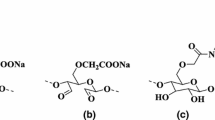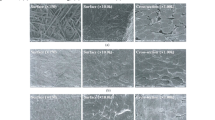Abstract
The paper is on introducing carbamate groups in sheets of cellulose fiber assemblies by pad-dry-cure treatments with aqueous solutions of polyethylene glycol, amide and salt. The effects of process variables—on carbamation levels and on mechanical properties of the substrate—are reported. Depending on treatment conditions, the nitrogen contents in substrates are in the range 0.668–2.252 wt%, corresponding to nominal degrees of carbamate group substitution of 0.08–0.28. The carbamation is initiated at 140 °C curing, and the levels rise with temperature up to 220 °C, but decrease at higher temperatures. The duration of curing also exerts an influence. There is a catalytic effect of sodium acetate on the carbamation, but the salt also induces a brown coloration in samples, which is likely a result of Maillard-type reactions. The treatments cause hydrolytic degradation in substrates, but there are options to adjust treatment conditions and minimize damage. Pad-dry-cure treatments are a common operation in the textile and paper industries, and the process may be adopted in commercial-scale operations to create derivatized paper or fabrics (woven, knitted or non-woven) for utilization in applications such as adsorbents for heavy metals from waste water, in hygiene products, in the creation of flame retardant products, or in creating all-cellulose composites by further treatment with alkali.







Similar content being viewed by others
References
Blagonravova IAA, Pronina IA, Aref’eva SM (1965) The catalytic effect of metallic salts on the reaction of isocyanates with hydroxy compounds. Lakokrasochnye Materialy i Ikh Primenenie 3-5, vide. Chem Abstr 1965:410534
Bredereck K, Hermanutz F (2005) Man–made cellulosics. Rev Prog Color Relat Top 35(1):59–75. doi:10.1111/j.1478-4408.2005.tb00160.x
Bridgeford DJ, Rahman M (1988) Cellulose aminomethanate sausage casings. European Patent 0282881A1
Chao Z, Sun D, Xie S (2011) Method for preparation of carbamic acid ester. China Patent 102134205A, vide. Chem Abstr 2011:953533
Chen GM, Huang YP (2001) Deconvolution method for determination of the nitrogen content in cellulose carbamates. Chin Chem Lett 12(4):365–368
Cheng B, Ren Y, Kang W (2007) Preparation of flame retardant cellulose fibers using carbamate. Fangzhi Xuebao 28:19-21, vide. Chem Abstr 2008:33911
DIN (1977-08) 54270-3 Testing of textiles; determination of the limit-viscosity of celluloses, EWNNmod(NaCl)-procedure
Ershova O, Costa E, Fernandes AS, Domingues MR, Evtuguin D, Sixta H (2012) Effect of urea on cellulose degradation under conditions of alkaline pulping. Cellulose 19(6):2195–2204. doi:10.1007/s10570-012-9791-4
Fulmer GR, Miller AJM, Sherden NH, Gottlieb HE, Nudelman A, Stoltz BM, Bercaw JE, Goldberg KI (2010) NMR chemical shifts of trace impurities: common laboratory solvents, organics, and gases in deuterated solvents relevant to the organometallic chemist. Organometallics 29(9):2176–2179. doi:10.1021/om100106e
Gaehr F, Hermanutz F (2002) Cellulose carbamate fibrous material suitable for low-salt dyeing and printing, its production and its use. World Patent 2002097175A2
Gokel GW (2004) Spectroscopy. In: Dean’s handbook of organic chemistry. 2nd edn. McGraw-Hill, New York, p 6.34
Guo Y, Zhou J, Song Y, Zhang L (2009) An efficient and environmentally friendly method for the synthesis of cellulose carbamate by microwave heating. Macromol Rapid Commun 30(17):1504–1508. doi:10.1002/marc.200900238
Heinze T, Liebert T, Koschella A (2006) Structure of polysaccharides. In: Esterification of polysaccharides. Springer, Berlin, pp 5–14
Higazy A, Hashem MM, Zeid NYA, Hebeish A (1996) The effect of non-cellulosic constituents on the behaviour of flax towards sodium chlorite, urea and dyes. J Soc Dyers Colour 112(10):281–286. doi:10.1111/j.1478-4408.1996.tb01758.x
Iller E, Stupińska H, Starostka P (2007) Properties of cellulose derivatives produced from radiation—Modified cellulose pulps. Radiat Phys Chem 76(7):1189–1194. doi:10.1016/j.radphyschem.2006.12.002
ISO (1998) 12947-3: Textiles—Determination of the abrasion resistance of fabrics by the Martindale method—Part 3: Determination of mass loss
ISO (1999) 13934-1: Textiles—Tensile properties of fabrics—Part 1: Determination of maximum force and elongation at maximum force using the strip method
Klemm D, Philipp B, Heinze T, Heinze U, Wagenknecht W (1998a) Comprehensive cellulose chemistry, vol. 2: Functionalization of Cellulose. Wiley-VCH Verlag GmbH, Weinheim, pp 161–164
Klemm D, Philipp B, Heinze T, Heinze U, Wagenknecht W (1998b) Comprehensive Cellulose Chemistry; vol. 1: Fundamentals and analytical methods. WILEY-VCH Verlag GmbH, Weinheim, pp 130–135
Klemm D, Philipp B, Heinze T, Heinze U, Wagenknecht W (1998c) Comprehensive Cellulose Chemistry; vol. 1: Fundamentals and Analytical Methods. WILEY-VCH Verlag GmbH, Weinheim, p 173
Koebel M, Strutz EO (2003) Thermal and hydrolytic decomposition of urea for automotive selective catalytic reduction systems: thermochemical and practical aspects. Ind Eng Chem Res 42(10):2093–2100. doi:10.1021/ie020950o
Kotek R (2007) Regenerated cellulose fibers. In: Lewin M (ed) Handbook of fiber chemistry. CRC Press, Boca Raton, pp 668–771
Kwak EJ, Lim SI (2004) The effect of sugar, amino acid, metal ion, and NaCl on model Maillard reaction under pH control. Amino Acids 27(1):85–90. doi:10.1007/s00726-004-0067-7
Laxen T, Hassi H (2007) Preparation of antimicrobial cellulose material from polysaccharides and its pharmaceutical applications. World Patent 2007135245A1
Loth F, Schaaf E, Fink HP, Kunze J, Gensrich HJ (2004) Procedure for preparation of cellulose carbamate in an inert organic solvent which is non-miscible with water. Germany Patent 10253672B3
Lundström A, Andersson B, Olsson L (2009) Urea thermolysis studied under flow reactor conditions using DSC and FT-IR. Chem Eng J 150(2–3):544–550. doi:10.1016/j.cej.2009.03.044
Maimaiti H, Kebier B (2011) Method for preparing cellulose sponge. China Patent 102212211A, vide. Chem Abstr 2011:1312576
McNeal I (2010) Adsorption of lanthanides on cellulose carbamate: silica hybrid materials. paper presented at the 41st middle atlantic regional meeting of the american chemical society, Wilmington, DE, United States, vide. Chem Abstr 2010:420793
Nada A-AMA, Kamel S, El-Sakhawy M (2000) Thermal behaviour and infrared spectroscopy of cellulose carbamates. Polym Degrad Stab 70(3):347–355. doi:10.1016/S0141-3910(00)00119-1
Nozawa Y, Higashide F (1981) Partially carbamate reaction of cellulose with urea. J Appl Polym Sci 26(6):2103–2107. doi:10.1002/app.1981.070260633
Rizzi GP (2008) Effects of cationic species on visual color formation in model maillard reactions of pentose sugars and amino acids. J Agric Food Chem 56(16):7160–7164. doi:10.1021/jf801197n
Schindler WD, Hauser PJ (2004) Softening finishes. Chemical finishing of textiles. Woodhead Publishing Limited, Cambridge, pp 29–42
Segal L, Seggerton FV (1961) Some aspects of the reaction between urea and cellulose. Text Res J 31(5):460–471. doi:10.1177/004051756103100510
Široký J, Blackburn RS, Bechtold T, Taylor J, White P (2010) Attenuated total reflectance Fourier-transform Infrared spectroscopy analysis of crystallinity changes in lyocell following continuous treatment with sodium hydroxide. Cellulose 17(1):103–115. doi:10.1007/s10570-009-9378-x
Struszczyk H, Starostka P, Urbanowski A, Mikoiajczyk W, Wawro D, Jozwicka J, Chodzinski J, Jarzebowski Z, Loster M, Nowotarski A, Wnuk J (1997) Preparation of cellulose carbamate forming stable spinning solution Germany Patent 19635246A1
Tajima H, Saito H (1997) Adsorbents containing cellulose carbamate for water treatment. Japan Patent 09099238A, vide. Chem Abstr 1997:361248
Vo LTT, Široká B, Manian AP, Bechtold T (2010) Functionalisation of cellulosic substrates by a facile solventless method of introducing carbamate groups. Carbohydr Polym 82(4):1191–1197. doi:10.1016/j.carbpol.2010.06.052
Vo LTT, Široká B, Manian AP, Duelli H, MacNaughtan B, Noisternig MF, Griesser UJ, Bechtold T (2013) All-cellulose composites from woven fabrics. Compos Sci Technol 78(1):30–40. doi:10.1016/j.compscitech.2013.01.018
Wendlandt WW, Kasper M, Bellamy S (1984) A TG—DSC investigation of the thermal dissociation of selected guanidinium salts. Thermochim Acta 75(1–2):239–244. doi:10.1016/0040-6031(84)85024-8
Woodings C (2001) New developments in biodegradable nonwovens. http://www.technica.net/magazines/emagazines.htm. Accessed 17 Dec 2012
Yang G, Zhang L, Feng H (1999) Role of polyethylene glycol in formation and structure of regenerated cellulose microporous membrane. J Membr Sci 161(1–2):31–40. doi:10.1016/s0376-7388(99)00095-2
Yin C, Shen X (2007) Synthesis of cellulose carbamate by supercritical CO2-assisted impregnation: structure and rheological properties. Eur Polymer J 43(5):2111–2116. doi:10.1016/j.eurpolymj.2007.01.041
Yin C, Li J, Xu Q, Peng Q, Liu Y, Shen X (2007) Chemical modification of cotton cellulose in supercritical carbon dioxide: synthesis and characterization of cellulose carbamate. Carbohydr Polym 67(2):147–154. doi:10.1016/j.carbpol.2006.05.010
Acknowledgments
The research leading to these results has received funding from the European Community’s Seventh Framework Programme [FP7/2007-2013] under grant agreement no. 214015. Dr. B. Široká gratefully acknowledges support from the Amt der Vorarlberger Landesregierung, Europäischer Fonds für Regionale Entwicklung (EFRE). Ms. Sandra Koeppel and Dr. Hai Vu-Manh (Research Institute of Textile Chemistry/Physics) are acknowledged for the assistance with nitrogen content determinations and for preparation of the FeTNa solvent respectively. The authors are indebted to the Höhere Technisches Bundeslehr- und Versuchsanstalt Dornbirn for access to their facilities.
Author information
Authors and Affiliations
Corresponding authors
Electronic supplementary material
Below is the link to the electronic supplementary material.
Rights and permissions
About this article
Cite this article
Vo, L.T.T., Hajji, F., Široká, B. et al. Direct carbamation of cellulose fiber sheets. Cellulose 21, 627–640 (2014). https://doi.org/10.1007/s10570-013-0116-z
Received:
Accepted:
Published:
Issue Date:
DOI: https://doi.org/10.1007/s10570-013-0116-z




